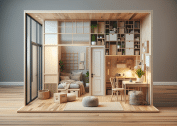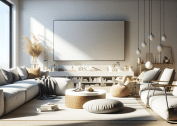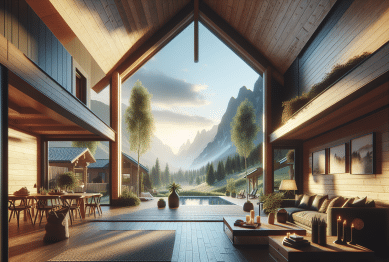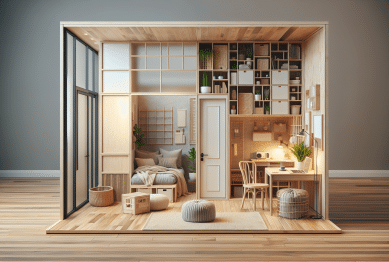Minimalist home design has become an inspiration for countless fans worldwide, blending simplicity with functionality and timeless style. Explore the reasons behind the popularity of minimalist interiors, the benefits they bring to daily living, and how you can create calming, clutter-free spaces while making the most of modern living trends.
The Rise of Minimalist Interiors in Modern Lifestyles
Minimalist home design started as a quiet movement that has grown into a powerful lifestyle statement. In cities and suburbs alike, people are reimagining their living spaces with fewer objects and more open areas, reflecting a widespread desire for simplicity and clarity. A clean home environment has become synonymous with mental clarity and reduced stress—a trend seen in social media, design magazines, and even in popular television shows that spotlight clutter-free living. Minimalism is more than just a visual style; it’s about streamlining choices and creating intentional spaces where each item has a purpose. The appeal seems universal, resonating with both busy professionals and families who crave peaceful spaces. Experts have found that minimalism can help lower anxiety by limiting distractions and focusing the mind (Source: https://www.apa.org/monitor/2019/03/ce-corner-cleanliness).
Why this style attracts so many admirers is an interesting question. Beyond aesthetics, minimalist interiors support efficient routines and flexible living arrangements. Fewer possessions mean less time spent organizing or cleaning, freeing up valuable hours for more meaningful pursuits. This design approach often correlates with environmental awareness, with many followers adopting recycling and upcycling habits as part of their home philosophy. The minimal aesthetic makes it easier to focus on what matters: relationships, personal passions, or quiet moments of reflection. Open spaces and natural light, both hallmarks of minimalist design, have been linked to better mood and well-being. Minimalism supports creating calming environments that appeal to people at every stage of life.
Minimalist interiors also reflect shifting societal values. There is growing interest in sustainability and intentional consumer choices. Instead of filling rooms with decorative items, the minimalist approach encourages investing in fewer, quality pieces that last longer. Families and individuals alike are discovering that their living spaces influence daily attitudes. A serene space can buffer life’s noise—a crucial draw in today’s fast-paced world. Many enthusiasts say a decluttered home inspires a decluttered mind, supporting focus for work, study, or relaxation. Minimalism’s subtlety is part of its strength: beauty, comfort, and style require only what’s truly needed, nothing more.
Key Principles That Shape the Minimalist Approach
Understanding minimalist interiors means recognizing a handful of practical, versatile rules. First among them: choose quality over quantity. This key principle influences featured furniture, lighting, and decor in every room. Minimalist homes often incorporate natural materials like wood or stone, neutral color palettes, and geometric shapes that project calm. Every piece in the room is selected with intention, with designers advocating for functional forms that serve daily needs without visual clutter. Even the walls may be left bare or adorned with a single piece of art, echoing the philosophy of less is more. Purposeful arrangement ensures free circulation and supports both comfort and movement within the space.
Another core concept is open space. Minimalist layouts allow rooms to breathe, arranging furniture to create wide pathways and unobstructed lines of sight. This fosters a feeling of freedom and ease. Ample natural light is another signature feature; large windows, sheer curtains, and glass doors help bring the outdoors inside. Hidden storage is another design trick. Cabinets and shelving are often built-in, letting residents tuck away items not in use. This ensures counters and surfaces remain clean and visually serene, avoiding the mental overload that clutter can cause. Minimalism is about balance—every addition is weighed for both necessity and aesthetic value.
The minimalist approach also emphasizes mindfulness in everyday living. This means rethinking impulsive purchases and decluttering regularly. Homeowners often evaluate what truly serves their happiness. Minimalist design draws on timeless shapes and harmonious proportions that never go out of style. Flexible living spaces are adapted for varied needs, from work to play to quiet evenings in. Well-chosen lighting and textiles soften any starkness and invite comfort without disorder. This philosophy extends even to digital organization—in many homes, it goes hand-in-hand with strategies for managing technology and information overload (Source: https://www.harvard.edu/in-focus/tips-for-minimalist-living/).
Benefits of Embracing Minimalism in the Home
The positive effects of minimalist home design go beyond visual appeal. Research has highlighted a link between tidy environments and lower stress levels, noting that people tend to feel calmer and more in control when their surroundings are well ordered. A minimalist home can become a private sanctuary—a buffer from the distractions of modern life. Clutter is known to provoke anxiety, reduce productivity, and even negatively affect sleep, but minimalist environments help to alleviate these problems. This style creates space not only physically but also mentally, allowing residents to rest and recharge. The result is a greater sense of well-being and peace.
Minimalism also supports greater organization and easier cleaning routines. With only essential items on display, it’s simpler to keep things in their proper place. Surfaces are easily wiped down, and floors are free from clutter, making everyday maintenance less taxing. For many, this means less time spent tidying and more time spent pursuing favorite hobbies or treasured relationships. The benefits extend to families, too—children find it easier to play and focus in organized, distraction-free spaces. This design philosophy helps promote independence and responsibility as each person learns to value and care for their designated possessions.
Financial benefits may surprise those new to minimalism. Investing in fewer, higher-quality items often leads to smaller, less frequent purchases and ultimately saves money. Many followers notice their shopping habits change, with a greater emphasis on thoughtful selection rather than impulse buys. Eco-consciousness is another positive outcome: fewer possessions mean less waste, supporting broader sustainability goals. Minimalist living is frequently associated with low environmental impact and a renewed appreciation for craftsmanship, resourcefulness, and simplicity. A minimalist home becomes a statement of values, promoting clarity, comfort, and mindful consumption every day (Source: https://www.epa.gov/smm/sustainable-management-materials-non-hazardous-materials-and-waste-management-hierarchy).
How to Start: Steps for Creating a Minimalist Space
Getting started with minimalist home design doesn’t need to be overwhelming. Begin with a single room, such as a bedroom or entryway, and assess what you use regularly. Remove or store excess decor, clothing, or gadgets. Experts suggest categorizing items by function and frequency of use—if something isn’t essential or doesn’t bring joy, consider donating or recycling it. Take your time and revisit the process every few weeks to refine the space further. This gradual approach feels more manageable and lets new habits take root. Starting small sparks confidence and reveals unexpected benefits quickly (Source: https://www.psychologytoday.com/us/basics/minimalism).
After decluttering, focus on the foundation of your space: select a calming color palette and invest in durable, multi-functional pieces. Neutral shades such as white, beige, or gray help create a sense of visual flow and calm. When choosing furniture, prioritize comfort and storage functions—think beds with drawers or coffee tables with shelves. Avoid overcrowding; leave generous walkways and let each object breathe. Introduce a few plants or natural elements for warmth. Lighting is critical, too: opt for fixtures that emit soft, even light and can be dimmed for different moods. Every change should serve both function and tranquility.
Consistency makes the minimalist style sustainable in the long term. Develop simple routines for staying organized—regularly sort mail, tidy up at the end of the day, and rehome anything that drifts out of place. Avoid filling empty surfaces just for the sake of decoration. Instead, celebrate open spaces and the feelings of calm they inspire. Involve the household in decisions; minimalism can be a family project, teaching children about mindful choices and collective upkeep. This approach creates a welcoming home that evolves with its residents, offering solace and focus for both special occasions and everyday living.
Minimalist Trends and the Influence of Technology
Technology and contemporary culture continually influence minimalist home design. Devices have become smaller and more integrated, making it easier to maintain uncluttered environments. Many followers of this trend incorporate smart storage, wireless charging docks, or compact appliances. Designers are drawing from Scandinavian and Japanese minimalism, merging global styles to create unique blends tailored to individual lifestyles. Digital art frames, voice-activated controls, and multi-use furniture all support the minimalist vision while embracing innovation. The popularity of virtual design consultations has made professional guidance more accessible, helping more households transition to minimalist living with confidence (Source: https://www.nytimes.com/wirecutter/blog/minimalist-home/).
Technology’s contribution goes beyond gadgets—apps and digital calendars help streamline daily routines and declutter mental space. Home automation can simplify chores, allowing lighting, temperature, and security to be managed remotely or scheduled for convenience. Minimalists often use digital solutions to manage photos and documents, keeping physical storage free for essential items only. These technological shifts align with minimalist values: efficiency, order, and ease. Designers aim for invisible integration, ensuring that technology serves the lifestyle without dominating the room. The overarching goal remains a harmonious, serene space that accommodates modern needs without excess.
Minimalism’s digital age popularity also ties into social influences. Online communities, blogs, and streaming platforms celebrate minimalist transformations and offer ongoing inspiration. Virtual tours, before-and-after showcases, and decluttering challenges have become entertainment in their own right, blending lifestyle advice with human stories. Experimentation is encouraged—there is no single correct path to minimalist living. Technology makes it easier than ever to access fresh ideas, problem-solve with like-minded enthusiasts, and personalize each step of the design process. This dynamic exchange keeps minimalist trends vibrant and adaptable, ensuring longevity for both style and substance.
Common Challenges and Practical Solutions for Minimalism
Embracing minimalist home design sometimes means facing practical obstacles. Letting go of sentimental items is among the toughest. Many struggle with emotional ties to gifts or collections accumulated over years. Experts recommend thoughtful review and, when possible, preserving memories with photographs instead of keeping every physical object. Psychological comfort can come from donating items, knowing they’ll benefit someone else. For families, striking a balance between individual needs and shared spaces is another frequent challenge. Communication and compromise are essential—every household member should feel their preferences are respected as minimalism takes root (Source: https://resources.uw.edu/information-technology-blog/minimalist-living).
Adapting minimalist principles to small or busy homes requires extra creativity. Flexible storage solutions such as under-bed bins, vertical shelving, or fold-down furniture can maximize usage of limited square footage. Some families establish shared guidelines, like seasonal decluttering or setting limits on new items brought in. The idea is not to enforce rigid rules but to shape routines that reflect each household’s rhythms. For parents, involving children in sorting and tidying activities can instill lifelong organizational skills. Simplicity should never come at the expense of comfort; minimalism is adaptable, with solutions for every stage of life and living arrangement.
One last obstacle is the misconception that minimalism equals bare or impersonal spaces. In reality, the most successful minimalist homes are those that blend function and personality. Warmth comes from carefully chosen textures, colors, and layers. Personal touches—family photos, heirloom furniture, or a favorite piece of art—anchor the home emotionally. The minimal look is never about deprivation, but about mindful selection. Tools and support are plentiful, from community workshops to professional organizers offering practical advice. Overcoming these challenges ensures that minimalist home design remains relevant, resilient, and a lasting source of satisfaction.
References
1. American Psychological Association. (2019). Clearing Clutter for Mental Clarity. Retrieved from https://www.apa.org/monitor/2019/03/ce-corner-cleanliness
2. Harvard University. (n.d.). Tips for Minimalist Living. Retrieved from https://www.harvard.edu/in-focus/tips-for-minimalist-living/
3. U.S. Environmental Protection Agency. (2022). Sustainable Management of Materials. Retrieved from https://www.epa.gov/smm/sustainable-management-materials-non-hazardous-materials-and-waste-management-hierarchy
4. Psychology Today. (n.d.). Minimalism. Retrieved from https://www.psychologytoday.com/us/basics/minimalism
5. The New York Times Wirecutter. (2023). Build a Minimalist Home. Retrieved from https://www.nytimes.com/wirecutter/blog/minimalist-home/
6. University of Washington IT Blog. (2023). Minimalist Living. Retrieved from https://resources.uw.edu/information-technology-blog/minimalist-living









